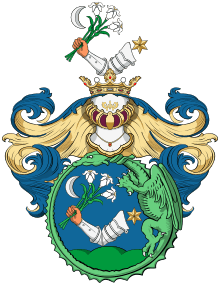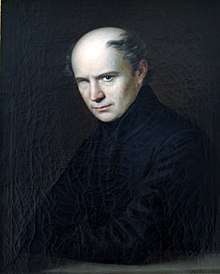Ferenc Kölcsey
Ferenc Kölcsey (archaically English: Francis Kolcsey,[1] 8 August 1790 in Sződemeter – 24 August 1838) was a Hungarian poet, literary critic, orator, and politician, noted for his support of the liberal current in Hungary regarding the politics involving the Austrian Empire. He wrote Himnusz, the national anthem of Hungary in 1823.


Biography
Kölcsey was born in Sződemeter, Hungary (now Săuca, Romania). He was orphaned at an early age and handicapped by the loss of an eye to smallpox. At age fifteen, he made the acquaintance of Ferenc Kazinczy and adopted his linguistic reforms. In 1809 Kölcsey went to Pest and became a notary to the Royal board. He was disenchanted with the office, and, while in Szatmárcseke, he devoted his time to aesthetical study, poetry, criticism, and the defense of Kazinczy's theories.
Kölcsey's early metrical pieces contributed to the Transylvanian Museum did not attract much attention, while his severe criticisms of Mihály Csokonai Vitéz, János Kis, and especially Dániel Berzsenyi, published in 1817, rendered him very unpopular. From 1821 to 1826 he published many separate poems of great beauty in the Aurora, Hebe, Aspasia, and other magazines of polite literature. He joined Pál Szemere in a new periodical, styled Élet és Literatúra (Life and Literature), which appeared from 1826 to 1829, in 4 vols., and gained for Kölcsey the highest reputation as a critical writer.
From 1832 to 1835 he sat in the Hungarian Diet, where his extreme liberal views and his eloquence soon rendered him famous as a parliamentary leader. Elected on 17 November 1830 a member of the Hungarian Academy of Sciences, he took part in its first grand meeting; in 1832, he delivered his famous oration on Kazinczy, and in 1836 that on his former opponent Dániel Berzsenyi. In 1838, when the opposition leader Miklós Wesselényi was thrown into prison upon a disputed charge of treason, Kölcsey conducted his defense with noted eloquence, but without success. He died about a week afterwards at Szatmárcseke, from internal inflammation.
Kölcsey's strong moral sense and deep devotion to his country are reflected in his poems, his often severe but masterly literary criticism, and his funeral orations and parliamentary speeches. His collected works, in 6 volumes, were published at Pest, 1840–1848, and his journal of the Diet of 1832–1836 appeared in 1848. The first collected edition of all his works appeared in 1886–87.
A monument erected to the memory of Kölcsey was unveiled at Szatmárnémeti on 25 September 1864. His poem Himnusz (1823), evoking the glory of Hungary's past, became the national anthem of Hungary.
Famous works
- Vanitatum Vanitas 1823.
- Himnusz 1823. The national anthem of Hungary
- Huszt 1831. Epigram
Honors
- Ferenc Kölcsey stamp were issued by Hungary on 5 May 1937.[2]
- On 3 August 1990 another postage stamp was issued.[3]
References
- Emil Reich (1899) Hungarian Literature: An Historical & Critical Survey. p. 107
- colnect.com/en/stamps/list/country/6955-Hungary/year/1937
- colnect.com/en/stamps/list/country/6955-Hungary/year/1990/page/5

External links
| Wikimedia Commons has media related to Ferenc Kölcsey. |
- Works by or about Ferenc Kölcsey at Internet Archive
- Works by Ferenc Kölcsey at LibriVox (public domain audiobooks)
